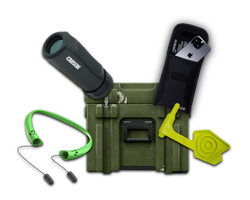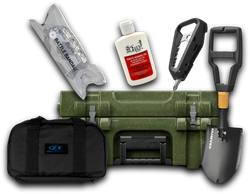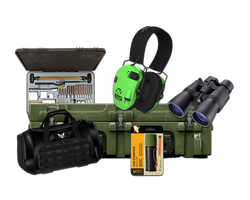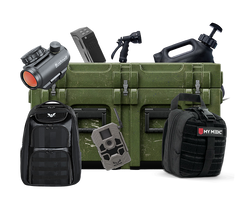How to Keep a Sleeping Bag Dry: Essential Tips for Every Adventurer
Table of Contents
- Introduction
- Understanding Moisture and Sleeping Bags
- Prevention Strategies Before Your Trip
- Best Practices During Camping
- Drying Techniques for Damp Sleeping Bags
- Choosing the Right Sleeping Bag
- Additional Gear for Moisture Management
- Conclusion and Final Thoughts
- FAQs
Introduction
Imagine this: it's a chilly night at your campsite, the stars twinkle above, and you're nestled in your sleeping bag, ready for a well-deserved rest after a day of adventure. Suddenly, you find yourself waking up to a damp, uncomfortable sleeping bag, dampening your spirits and ruining your night. A wet sleeping bag can lead not only to discomfort but also to serious risks like hypothermia during colder nights. Knowing how to keep a sleeping bag dry is crucial for any outdoor enthusiast, whether you're embarking on a weekend camping trip or a week-long trek through rugged terrain.
In this comprehensive guide, we will explore the best practices for keeping your sleeping bag dry in various conditions. From understanding the science behind moisture to practical tips for keeping your gear in top shape, we’ll cover everything you need to know. The focus will be on enhancing your camping experience and ensuring that you stay comfortable and safe, no matter the weather. By the end of this article, you will be equipped with effective strategies that can make a significant difference in your outdoor adventures.
We will delve into the following key topics:
- Understanding Moisture and Sleeping Bags
- Prevention Strategies Before Your Trip
- Best Practices During Camping
- Drying Techniques for Damp Sleeping Bags
- Choosing the Right Sleeping Bag
- Additional Gear for Moisture Management
- Conclusion and Final Thoughts
- FAQs
Let’s get started on ensuring that your sleeping bag stays dry, no matter what challenges the great outdoors may throw at you!
Understanding Moisture and Sleeping Bags
Moisture control is a fundamental aspect of outdoor camping that can significantly affect your comfort and safety. There are several sources of moisture that can infiltrate your sleeping bag:
- External Moisture: This includes rain, dew, and snow that can wet your sleeping bag from the outside.
- Internal Moisture: This comes from your body, primarily through perspiration and breath. Even on a cool night, the warmth of your body can create condensation inside the bag, leading to dampness.
The Science Behind Moisture Accumulation
Understanding how moisture accumulates can help you develop strategies to prevent it. When warm air from your body meets the cold fabric of your sleeping bag, condensation occurs. This is especially true in colder environments where the temperature difference is greater.
Condensation Factors:
- Ambient Temperature: The colder it is outside, the more likely condensation will form.
- Humidity Levels: High humidity can exacerbate moisture issues, making it essential to manage airflow and ventilation in your sleeping area.
Why Keeping Your Sleeping Bag Dry Matters
A damp sleeping bag can lose its insulating properties, making it ineffective in keeping you warm. In severe cases, it can lead to hypothermia, especially in colder climates. Understanding these factors is key to ensuring that you remain warm, dry, and safe during your camping adventures.
Prevention Strategies Before Your Trip
Preparation is your first line of defense against a wet sleeping bag. Here are several strategies to consider before you head out:
1. Select the Right Sleeping Bag
Choosing the right sleeping bag for your environment is crucial. Consider the following:
- Insulation Type: Down sleeping bags are lightweight and compressible but lose insulation when wet. Synthetic bags perform better in wet conditions as they retain warmth even when damp.
- Temperature Rating: Ensure your sleeping bag is rated for temperatures lower than what you expect to encounter during your trip. This can help minimize sweating and moisture accumulation.
2. Use a Waterproof Stuff Sack
When you're on the move, use a waterproof stuff sack to store your sleeping bag. This will protect it from rain and moisture while hiking or when packing your gear at the campsite.
3. Plan Your Campsite Location
Select a campsite that minimizes exposure to moisture:
- Avoid Low-Lying Areas: Pitch your tent on elevated ground to avoid pooling water.
- Check the Weather: Be aware of rain forecasts and plan accordingly.
4. Bring a Ground Cloth or Tarp
Using a ground cloth or tarp under your tent will act as a barrier against moisture from the ground, which can seep into your sleeping bag.
5. Ventilation Preparations
Ensure your tent has adequate ventilation options. This can help reduce condensation and keep the interior of your tent (and sleeping bag) drier.
Best Practices During Camping
Once you’ve set up camp, there are several actions you can take to keep your sleeping bag dry:
1. Control Your Body Temperature
Avoid overheating in your sleeping bag as this can lead to perspiration. Here are some tips to regulate your body temperature:
- Layering: Use a base layer that wicks moisture away from your skin. Avoid cotton as it traps moisture.
- Unzip as Needed: If you start to feel warm, unzip your sleeping bag partially to allow moisture to escape.
2. Keep Gear Off the Ground
Use a gear loft or hang your sleeping bag from a line inside the tent. Keeping it off the ground reduces the risk of moisture wicking up from the wet ground.
3. Maintain Tent Ventilation
Open vents or leave the tent door slightly ajar (if safe) to promote airflow. This helps to carry away excess moisture that can accumulate inside the tent.
4. Use a Bivy Sack
A waterproof bivy sack can provide extra protection for your sleeping bag, especially in wet conditions. It acts as a barrier to external moisture while allowing some breathability.
Drying Techniques for Damp Sleeping Bags
If your sleeping bag does happen to get damp, it's crucial to dry it out as quickly as possible to maintain its insulating properties. Here are some effective methods:
1. Air It Out
If you notice your sleeping bag is damp in the morning, hang it up to air out while you prepare breakfast. If the sun is out, take advantage of the warmth to help evaporate moisture.
2. Use a Hot Water Bottle
In the morning, you can place a hot water bottle inside your sleeping bag for a short period. This will not only warm up the bag but can help evaporate any residual moisture.
3. Shake It Out
Gently shake out your sleeping bag to redistribute any clumped insulation, which can help it loft back up and aid in drying.
Choosing the Right Sleeping Bag
Selecting the appropriate sleeping bag is essential for staying dry and comfortable. Here are some tips:
1. Evaluate Insulation Materials
- Down: Lightweight, compressible, and warm, but vulnerable to moisture. Ideal for dry conditions.
- Synthetic: Retains warmth even when wet and dries faster. Best for wet or unpredictable weather.
2. Consider the Shape
Mummy-shaped sleeping bags tend to be warmer due to their snug fit. They minimize air pockets that can cool down, making them a solid choice for colder temperatures.
3. Look for Water-Resistant Treatments
Many modern sleeping bags come with water-resistant treatments to help repel moisture. This can add an extra layer of protection against dampness.
Additional Gear for Moisture Management
In addition to your sleeping bag, consider incorporating other gear that can help keep you dry:
1. Waterproof Tent
Invest in a high-quality waterproof tent that can withstand rain and keep the interior dry.
2. Ground Pad
A well-insulated ground pad can create a barrier between your sleeping bag and the cold, damp ground, providing additional insulation.
3. Dry Bags for Other Gear
Use dry bags for all your gear, not just your sleeping bag. Keeping your tent, clothes, and other essentials dry is critical in wet conditions.
Conclusion and Final Thoughts
Keeping your sleeping bag dry is an essential skill for any outdoor adventurer. By understanding the factors that contribute to moisture accumulation and implementing effective prevention strategies, you can ensure a more enjoyable camping experience. Remember to choose the right sleeping bag for your conditions, utilize waterproof gear, and maintain proper ventilation in your tent.
With these tips in mind, you can set off into the wild with confidence, knowing you have the knowledge to stay dry and comfortable. Don’t forget to check out Crate Club's subscription service for high-quality tactical gear and survival tools to enhance your outdoor adventures. With options ranging from the Lieutenant tier for beginners to the General tier for seasoned pros, you'll find gear that meets your needs—take a look at what we offer here. You can also explore our Crate Club Shop for the latest in tactical gear.
FAQs
1. What should I do if my sleeping bag gets wet?
If your sleeping bag gets wet, air it out immediately and hang it if possible. Use a hot water bottle inside to help dry it out.
2. Can I use a down sleeping bag in wet conditions?
While down sleeping bags are warm and compressible, they do not perform well when wet. Consider using a synthetic sleeping bag in wet conditions.
3. How can I prevent condensation in my sleeping bag?
Ensure proper ventilation in your tent, avoid overheating, and use moisture-wicking clothing to minimize perspiration.
4. Is it worth getting a bivy sack?
Yes, a bivy sack can provide additional protection against moisture and is particularly useful in wet conditions or when you're camping without a full tent.
5. What is the best type of sleeping bag for camping in variable weather?
A synthetic sleeping bag is generally recommended for variable weather as it retains warmth even when damp. However, if you're in a dry climate, a down sleeping bag may offer better insulation.
By mastering these techniques, you'll be well-prepared for your next outdoor adventure, ensuring that your sleeping bag remains dry and your camping experience is enjoyable and safe. Happy camping!
Share this article



